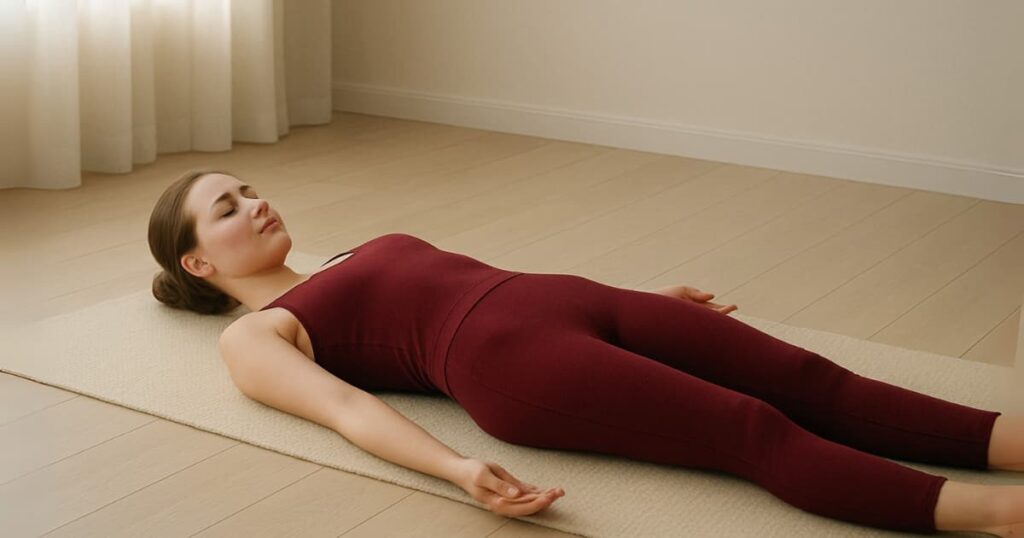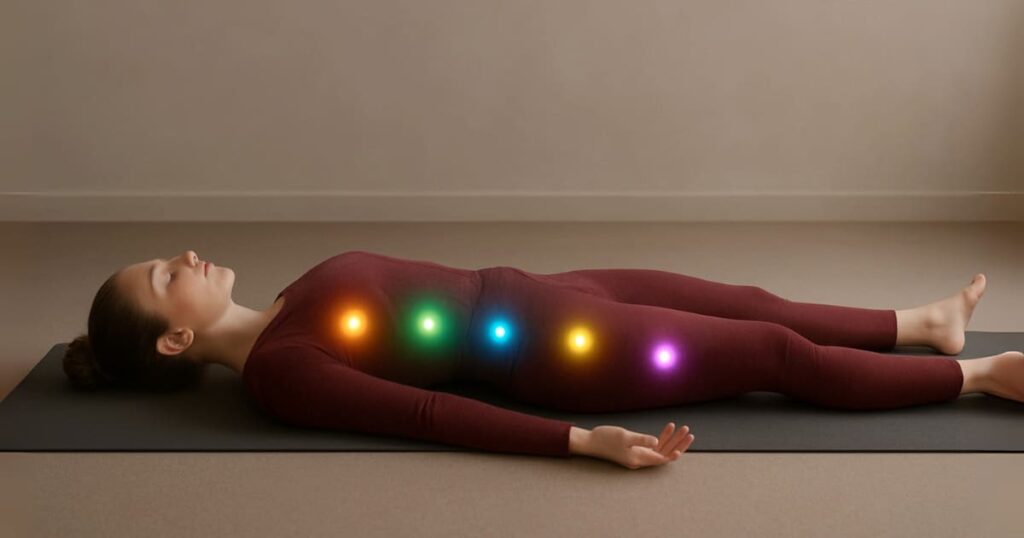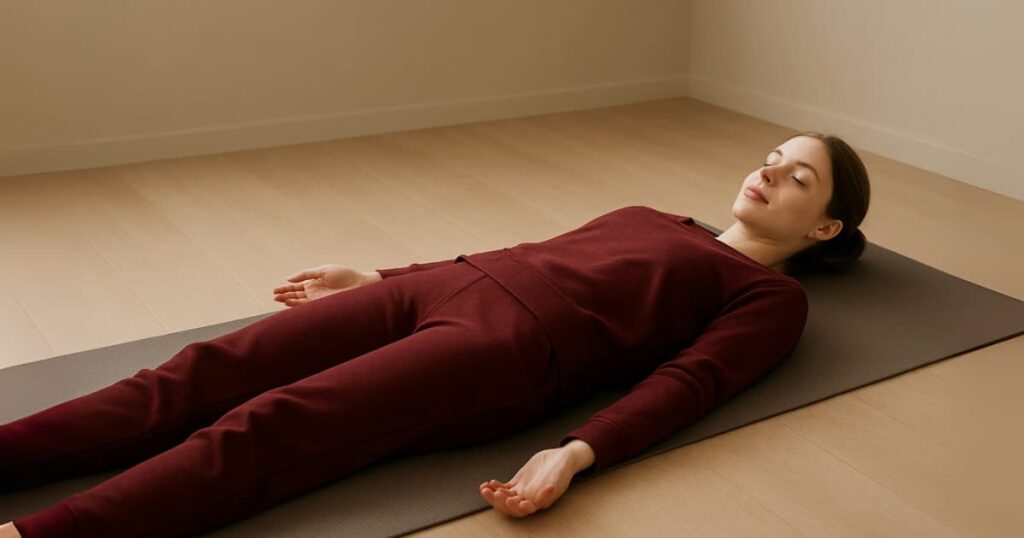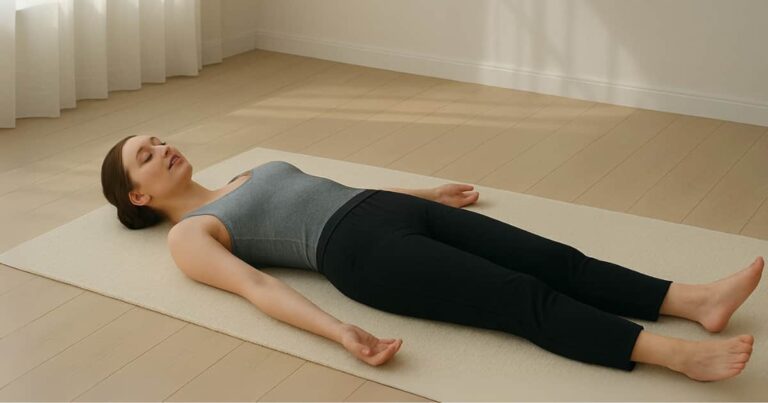
Let’s be real – when was the last time you woke up feeling truly refreshed? If your idea of “relaxation” is passing out with your phone in hand, we need to talk. Enter Yoga Nidra for deep relaxation, the closest thing to a magic reset button for your frazzled nervous system.
This isn’t another meditation app gimmick. Yoga Nidra for deep relaxation delivers what your 3 AM stress-scrolling can’t:
- Actual physiological rest (proven by science)
- Mental quiet without the “empty your mind” struggle
- All the benefits of a 4-hour nap in 30 minutes
I discovered this practice after hitting absolute burnout (think: caffeine-powered zombie mode). The transformation was so dramatic, my barista asked if I’d quit coffee. (Spoiler: I didn’t.)
In this guide, you’ll get:
✓ The neuroscience behind why Yoga Nidra for deep relaxation works when nothing else does
✓ How to practice it even if you can’t sit still for 5 minutes
✓ My embarrassing beginner mistakes so you can skip them
No chanting. No awkward positions. Just proven recovery for people who are tired of being tired.
What Is Yoga Nidra? A Yogic Sleep Beyond Sleep
Let me tell you about Yoga Nidra the way I’d explain it to my coffee-addicted best friend who thinks “relaxation” means scrolling Instagram until 2 AM.

First things first – Yoga Nidra isn’t:
✖️ Another meditation app trying to sell you peace
✖️ Some mystical practice requiring a PhD in Sanskrit
✖️ About twisting into uncomfortable positions
It’s basically the lazy person’s guide to deep rest. You know that delicious feeling when you’re half-asleep on Sunday morning, cozy under the blankets? That’s the zone we’re aiming for – except you stay awake the whole time.
Here’s why my overworked friends swear by it:
• Your body gets the same recovery as 4 hours of sleep
• Your brain actually shuts up for once (no more mental to-do lists)
• You can do it in pajamas (no yoga pants required)
The science behind it is pretty cool:
→ Starts in busy-brain mode (where you live 24/7)
→ Shifts to relaxed-alert mode (when you’re reading a good book)
→ Hits that sweet dreamy state (right before deep sleep)
What makes it better than meditation? Zero effort required. You just lie there like a starfish and let someone’s voice guide you. No “clearing your mind” nonsense.
Pro tip: If you’ve ever fallen asleep during a massage, you’ll love this. It’s like that, but without the awkward drooling.
Yoga Nidra vs. Meditation: What’s the Difference?
Meditation vs. Yoga Nidra
Okay, let’s get real about this whole meditation vs Yoga Nidra thing. I used to think they were basically the same until I tried doing actual meditation and nearly lost my mind trying to “focus on my breath” for more than 30 seconds.
Meditation is like…
That teacher who made you sit up straight in class
Trying to herd cats (your thoughts) into neat little boxes
Getting a mental workout when you just wanted to relax
Yoga Nidra is like…
Your cool aunt who lets you lie on the couch all day
Floating in a pool without having to actually swim
Getting all the benefits of a nap while technically being awake
Here’s what really matters:
- Meditation = you’re working (focusing, observing, trying not to think about lunch)
- Yoga Nidra = you’re receiving (just lying there while someone nice talks to you)
The science bit (simplified):
When you meditate, your brain is in “lightly relaxed but still working” mode. With Yoga Nidra, it’s in “deep rest but still aware” mode – like when you’re half-asleep but still hear your name being called.
Which one should you try?
- If you enjoy mental challenges → Meditation
- If you enjoy being horizontal → Yoga Nidra
- If you can’t sit still for 2 minutes → Definitely Yoga Nidra
Why Yoga Nidra Actually Works (Backed by Science, Not Magic)
Let’s cut through the wellness buzzwords. Yoga Nidra isn’t some mystical cure-all – it’s basically a system reboot for your entire being. And now even lab-coat-wearing scientists are nodding along.
For Your Overthinking Brain
• Slashes stress chemicals (goodbye, cortisol rollercoaster)
• Helps process emotional baggage without therapy prices
• Unlocks creative ideas you didn’t know you had (take that, artist’s block)
For Your Exhausted Body
• 30 minutes = 3-4 hours of deep sleep (no, that’s not a typo)
• Lowers blood pressure better than pretending you’re calm
• Boosts immunity by telling stress to take a hike
Real Research Says
A proper 2022 study confirmed what tired people already knew: Yoga Nidra beats counting sheep for sleep, out-performs deep breathing for anxiety, and generally makes life more manageable.
Why This Beats Regular Naps
• No groggy wake-up confusion
• You remember doing it (unlike that time you passed out during that movie)
• Actually leaves you refreshed instead of needing another nap
The best part? Your only job is to lie there. No effort required. It’s like finding money in last season’s jacket – unexpected but very welcome.
Why Yoga Nidra Actually Helps When You Can’t Sleep or Stop Worrying
Let’s be honest – when your brain won’t shut off at 2 AM, most sleep advice feels useless. But here’s why this practice actually works when counting sheep fails miserably:
For People Who’ve Tried Everything to Sleep
• It physically relaxes your body from toes to forehead (no muscle left behind)
• Gives your racing thoughts something useful to do instead of panicking
• Actually triggers your body’s natural sleep systems without pills
For When Anxiety Won’t Quit
• Provides a kind voice to follow instead of leaving you alone with scary thoughts
• Creates just enough structure that anxious minds can actually relax
• Feels safe because you’re guided every single step
What Actually Changes in Your Body
Your heart rate slows down whether you want it to or not
Your breathing automatically deepens
Your muscles unlock even if you’re still mentally wired
Why Anxious People Prefer This Over Meditation
Regular meditation can feel like being told to calm down while standing on a tightrope. Yoga Nidra feels like someone installed safety nets and is cheering you on.
The best evidence? I no longer watch entire sunrises from the wrong side of morning
How to Practice Yoga Nidra for Deep Relaxation at Home: A Step-by-Step Guide
Let’s cut through the confusion – you don’t need special gear or a silent retreat to make this work. Here’s the real deal on practicing without any fuss:

Step 1: Get Comfy (No Really)
Find any quiet spot where you won’t be interrupted
Lie flat on your back like a happy starfish
Use pillows anywhere you want – this isn’t a posture test
Step 2: Pick Your Mental Magic Words
Choose one simple positive phrase
Repeat it silently like a gentle whisper
Examples that work: “I’ve got this” or “I allow rest”
Now Step 3: The Body Scan Secret
Follow the guide’s voice from toes to nose
Your only job: notice each body part exists
This physically switches off stress mode
Step 4: Breathe Normally (Seriously)
No fancy breathing techniques required
Just notice air coming in and going out
Your body knows how to do this part
Step 5: Let Your Brain Daydream
Gentle visualizations might appear
You’re not trying to force anything
Think of it as mental cloud-watching
Next Step 6: Wake Up Refreshed
Slowly return to normal awareness
You’ll feel oddly refreshed
No grogginess guaranteed
Pro Tips for Real Beginners:
Start with 10 minute sessions
Use free audio guides online
Practice when you’re already tired
Expect to sometimes fall asleep (that’s normal!)
The beautiful part? You literally just lie there while someone’s kind voice does all the work. It’s the laziest form of self-care ever invented.
A 5-Minute Yoga Nidra Script for Deep Relaxation
Here’s a tiny taste of Yoga Nidra – no special skills required. Think of it as a trial version before you commit to the full program:
Get comfy wherever you’re reading this
Close your eyes (after reading these instructions please)
Breathe in slowly… and out even slower
Now bring your attention to:
• Your right hand
• Each finger (yes, even that weird pinky)
• Your entire arm
• That shoulder that’s been tense since Tuesday
Let everything feel heavy and relaxed like you’re melting into your surface
Whisper in your mind three times:
“I am okay right now”
Take three more lazy breaths
Open your eyes whenever you feel ready
This isn’t the full experience – it’s like tasting cake batter before baking the whole thing. But it might just convince you that your brain deserves more of this rest stuff.
Your Guide to Yoga Nidra for Deep Relaxation: Beginner FAQs Answered
Not even close. You stay awake the whole time while your body gets all the repair work of deep sleep. It’s like getting a full night’s rest during your lunch break.
Start with 10 minutes when you’re already tired (that’s most of us). Consistency beats marathon sessions – doing it twice a week actually works better than one hour-long struggle.
Ha! I wish. You still need actual sleep, but this makes your normal sleep count double. It’s like turning your 6 hours into premium 8-hour quality rest.
Usually yes – but if you’ve got serious trauma history, maybe don’t use random YouTube videos. Find someone trained in trauma-sensitive practices.
Nope. Your phone, headphones, and floor work perfectly fine. I started using free recordings during pandemic lockdowns and still use them.
Yoga Nidra vs. Other Relaxation Techniques
Let’s be real—most “relaxation techniques” feel like putting a bandage on a broken arm. After trying everything from breathing apps to adult naptime, here’s what actually works:
Guided Meditation
Like trying to relax while someone reads you assembly instructions for furniture you don’t own.
Five-Minute Body Scans
The spiritual equivalent of using one paper towel to clean up a spilled drink.
Hypnosis
Great if you want to cluck like a chicken on command, less great if you want to stay in control.
Yoga Nidra for deep relaxation
You don’t try. You don’t focus. You literally just lie there while your body does all the repair work. It’s the difference between watching a mechanic fix your car versus waking up to find it’s been magically repaired overnight.
You stay conscious enough to know what’s happening but relaxed enough that your brain can’t interrupt with its usual nonsense about that embarrassing thing you did in 2012.
Conclusion: Embrace profound healing with Yoga Nidra for deep relaxation
Our world treats busyness like a trophy, but what if your secret weapon was doing less? Not zoning out with your phone, but actual conscious rest where you’re awake for the benefits.
Yoga Nidra for deep relaxation is your permission slip to push pause. It’s that quiet corner you can visit without needing special skills or expensive gear. You don’t have to be flexible, spiritual, or even fully awake—just willing to lie down and push stop on the chaos.
If your brain won’t quit replaying that awkward thing you said in 2017, or if you’re tired of staring at the ceiling at 2 AM, this might help. It’s simple, it’s free, and honestly? It feels better than scrolling through bad news on your phone.
Try it tonight. Twenty minutes might just feel like a full system reset.
Important Note (Because Lawyers Made Me Write This)
Hey, real quick before you try anything: I’m just a person with a keyboard, not a medical professional. This article is like getting advice from a friend who reads too many wellness blogs – take it with a grain of salt (but maybe check with your doctor first).
If you’ve got actual health concerns, please talk to someone with a medical degree. Your doctor’s opinion will always be more valuable than anything you find online (yes, even if it’s written with charming self-deprecating humor).
Think of this as inspiration, not instruction. Your body is unique – treat it that way.
🔗 Love mindful living? Follow us on Pinterest and LinkedIn for daily meditation tips, peaceful visuals, and more




